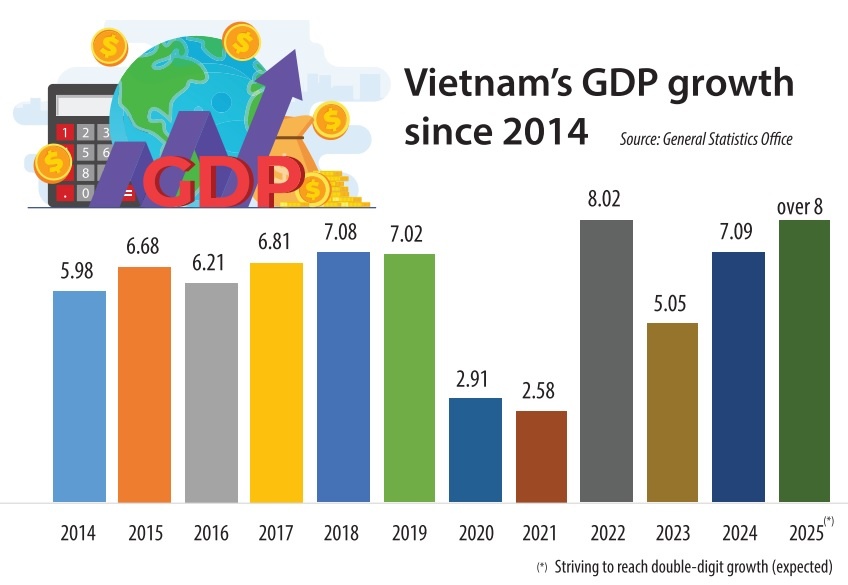
Vietnam is one of the world’s fastest growing economies, and Ho Chi Minh City is often named as one of the world’s most dynamic city.
This means more and more international companies will come to Vietnam to do business, and this, in turn, leads to increased job opportunities and boosts the importance of HCMC as a major economic centre.
Vietnam’s population and economy are on the rise. There is a vibrant jobs market and a labour force that is expanding by more than one million people every year.
The population continues to benefit from the strong economic development since “Đổi Mới”, the name given to the economic reforms initiated in 1986, and Vietnam is recognised internationally for investment and growth.
In recent years, Vietnam has enhanced its global economic reputation and entrenched its role as one of the most exemplary offshoring locations in the world. HCMC is the main centre for offshoring in the country with almost double the amount of companies taking advantage of its ideal position in comparison with its northern city, Hanoi.
What is the reason behind this phenomenal development and how do multinational corporations make good use of these factors?
1) Economic growth & investor momentum

Sustained GDP growth and rising FDI show a market where demand, infrastructure investment and government support create a reliable base for long-term teams and contracts. Investors want macro stability (so payroll, rents, services and supply chains are predictable) and growth (so local suppliers and talent keep improving).
Where Vietnam stands: Vietnam continues to grow faster than most regional peers. The World Bank’s 2025 Vietnam update projects ~6.8% GDP growth in 2025, and official Vietnamese statistics recorded strong 2024 growth (over 7%) — a sign of ongoing momentum into 2025.
- Ease of doing business: The country ranks 70th out of 190 economies in the World Bank’s Doing Business report and has signed over 15 free trade agreements, including the EU–Vietnam Free Trade Agreement (EVFTA) and membership in the Comprehensive and Progressive Agreement for Trans-Pacific Partnership (CPTPP). These agreements give investors in Vietnam preferential access to markets representing more than half of global GDP.
- FDI & capital flows: registered and disbursed FDI rose into record territory recently — registered FDI in 2024 was reported at about US$38.2 billion and disbursed FDI hit a record ~US$25.35 billion, demonstrating continued investor appetite in manufacturing, tech, and services. Ho Chi Minh City remains the primary magnet for new registrations.
Practical takeaway: Ho Chi Minh City offers investors sustained growth, record FDI inflows, and preferential trade access, making it a reliable hub for long-term outsourcing investment.
2) Cost of talent
Labor cost is often the single biggest line item companies optimise when offshoring. Savings are only valuable when quality and delivery timelines remain acceptable — so you need precise, current salary numbers to model true savings.
Where Vietnam stands: recent salary aggregators show Vietnam’s developer wages are sharply lower than Western markets while rising for senior roles:
- Median (all levels) software engineer: about ₫22,500,000/month (NodeFlair, updated Sept 2025). That’s roughly ~USD 900–1,000 per month (depending on exchange rate) for a median local engineer; senior engineers are higher.
- Compensation ranges published by Levels.fyi and market reports show total compensation packages vary widely (junior → lead), but Vietnam’s typical local cost for devs remains significantly below Western Europe / North America, allowing meaningful team-size and margin advantages.
Practical takeaway: you can staff a 10–30 person team in HCMC for a fraction of the cost of hiring the same team in Paris/London/NY, yet still access mid-level and senior talent as your operations mature.
3) Talent supply & STEM education

Fast hiring and predictable ramping require a steady flow of qualified graduates. For outsourcing (QA, designers, devs), you need both volume (to staff many roles) and quality (to hit global standards quickly).
Where Vietnam + HCMC stand:
- Youthful workforce: Vietnam’s median age is in the low 30s — recent World Bank data (and national statistics) put the median age around ~33 years, supporting a large, trainable working population.
- University pipeline (HCMC): Ho Chi Minh City has over 80 universities and colleges with a student population of ~400,000+, producing tens of thousands of graduates every year in engineering, IT, design and business — a steady pipeline for junior & mid roles. (List of universities & city education stats).
- STEM / ICT graduates: government and market sources indicate tens of thousands of ICT/engineering graduates annually (figures commonly quoted in the 50–80k IT grad range per year nationally depending on the metric used), and the state has explicit targets to expand ICT/STEM capacity through 2030.
- PISA / baseline skills: Vietnam has performed very well in global student assessments (PISA results show strong math & science performance for participating cohorts), supporting the narrative of a serious STEM foundation.
Practical takeaway: HCMC gives you deep hiring pools for QA / junior devs / designers today, and a predictable flow of new talent to scale teams quickly.
4) Internet & digital infrastructure

Remote work, cloud build pipelines, video interviews, large asset transfers, CI/CD, and virtual collaboration all depend on fast, reliable internet — both in offices and in staff homes. Poor connectivity kills velocity.
Where Vietnam stands: Vietnam has made a dramatic connectivity leap in 2025 — median fixed broadband speeds surged (driven by fiber and large ISP upgrades).
- Vietnam is ranked 16th globally in mobile internet speed and 10th in fixed broadband speed in 2025 according to Ookla’s Speedtest Global Index. Ho Chi Minh City in particular benefits from widespread fiber-optic coverage, free Wi-Fi in most public places, and competitive costs that make it one of the most affordable high-speed internet hubs in Asia.
- Recent independent measurements show Vietnam with median fixed speeds in the 200+ Mbps range (August 2025 figures reported ~261–271 Mbps, depending on source and month).
Practical takeaway: HCMC offices and many residential areas already support the bandwidth needs of modern software teams — streaming meetings, remote pipelining, and cloud access are reliable. For critical workloads, investors still add redundancy (multi-ISP, backup power), but the base level of service is now world-class.
5) Legal & policy
Predictable company setup, tax clarity, IP protection, and visa/work-permit rules determine how fast you can hire, how you structure contracts, and whether IP and data are safe/legal under local law. Incentives meaningfully change the ROI on local offices or R&D hubs.
Where Vietnam stands:
- Special investment procedure (Decree 19/2025): Vietnam introduced a special investment procedure (Decree No. 19/2025) in early 2025 creating a fast-track pathway for qualifying projects (notably high-tech, R&D, innovation). This shortens approval timelines and simplifies certain permits — useful for tech investors who want a quicker start.
- Tax incentives for high-tech / hi-tech parks: qualifying high-tech enterprises (and investments in hi-tech parks) remain eligible for generous CIT incentives (common structures: 4 years’ tax exemption, followed by a period with reduced rates such as 50% reduction for a number of years, plus other location or sector incentives). Saigon Hi-Tech Park and other special zones offer attractive tax regimes for R&D and high-value tech projects.
- Regulatory direction: overall policy has been moving to facilitate foreign investment into tech and innovation (new rules to speed approvals, encourage FDI into semiconductors/AI, and improve administrative processes). Use local counsel to ensure qualification for incentives and to structure IP/data appropriately.
Practical takeaway: if your project qualifies (R&D, high-tech, digital services), you can often secure meaningful tax and administrative advantages — and Decree 19 gives a true, faster route to get a project approved.
6) Outsourcing ecosystem & corporate presence
You don’t want to be the only foreign company in a city without local partners, recruitment firms, office providers, or service vendors. A dense ecosystem (local outsourcers, global firms, training academies) reduces risk and speeds hiring/operations.
Where Vietnam + HCMC stand:
- IT industry scale & companies: national reports and industry bodies point to 1,500+ digital / ICT companies serving foreign markets (many based or with large teams in HCMC), and VINASA remains the main industry association with hundreds of member firms. Large multinationals (Intel, Samsung, FPT, SAP investing R&D in HCMC) operate at scale in Vietnam.
- Market & outsourcing revenue: industry trackers put Vietnam’s IT/outsourcing market in the hundreds of millions (US$~0.7B in 2024/2025 projections) with strong CAGR expectations — signaling market specialization and growing exportable services.
- Startup & innovation clusters: Ho Chi Minh City has become Vietnam’s prime tech/startup hub — Startup Genome and local reporting show HCMC rising in global startup rankings and registering billions in ecosystem value, helping foreign clients access local product teams, designers and modern SaaS practices.
Practical takeaway: you’ll find local partners, experienced outsourcers, recruitment partners, R&D talent and an innovation network in HCMC — so launching an offshoring team is operationally easy and commercially efficient.
7) Logistics & global connectivity
Fast air and sea links let global clients, visiting executives, and equipment move quickly. For some projects you still need occasional in-person meetings; ease of access reduces travel friction and cost.
Where HCMC stands:
- Air: Tan Son Nhat remains Vietnam’s busiest airport; recent terminal expansions (e.g., Terminal T3) significantly lift capacity — when the new domestic/international reorganisation and Long Thanh project finalize, the region’s connectivity will strengthen further. Current and near-term capacity increases make Ho Chi Minh City easy to reach from Asia, Europe and Oceania.
- Sea / port: Saigon Port (Port of Ho Chi Minh City) is Vietnam’s primary southern gateway with a large handling capacity (annual throughput in the multi-million tons / TEU range) and modern terminals serving regional shipping lines. It remains crucial for logistics and the city’s commercial clout
Practical takeaway: both fast person-to-person travel and bulk logistics are excellent — helping multinational teams visit frequently and move hardware or goods when projects require it.
Concrete Investor Actions: How to Capture Vietnam’s Advantage with Remote Resources
Investors want steps, not platitudes. The fastest way to leverage Ho Chi Minh City and Vietnam’s strengths is to partner with a local expert who can bridge global standards with local talent. That’s where Remote Resources comes in.
Actionable steps:
- Tap into incentives without red tape → Remote Resources helps investors assess eligibility for “special investment” categories (R&D, high-tech, innovation) and navigate fast-track processes such as Decree 19 tax breaks.
- Build blended teams at scale → We source and manage 60–80% of roles locally (junior to mid-level engineers, QA, designers) while supporting remote or expatriate hires for leadership, ensuring both cost-efficiency and global-standard oversight.
- Accelerate talent readiness → With access to HCMC’s STEM pipeline, Remote Resources runs tailored recruitment, onboarding, and applied training programs that turn graduates into product-grade staff within weeks.
- Anchor in the right locations → From Saigon Hi-Tech Park to co-working hubs, we help clients establish the first footprint while keeping operations fully managed, so companies can scale without needing to set up a legal entity immediately.
With Remote Resources, investors don’t just hire individuals — they build entire offshore teams in HCMC, fully managed and investment-ready from day one.









